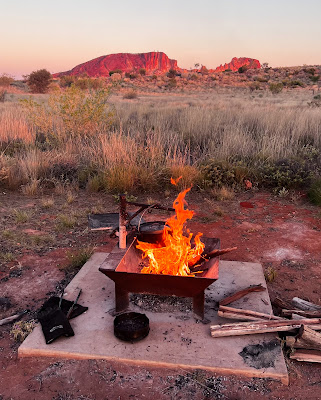After leaving Rainbow Valley, we drove north to Alice Springs with a brief stop to refuel, including filling two jerry cans.
Then, it was a further sixty-eight kilometres north along the Stuart Highway before turning east onto the Plenty Highway. Just over sixty kilometres later, we passed by Gemtree, which has a caravan park and a gem fossicking area.
This is our fourth trip across the Plenty and Donohue, and even though there are large sections of dirt, it's still a quicker option to travel into Queensland than taking the bitumen north and across the Barkly Tableland.
It's probably four years since we last crossed this way, and we were surprised to see that the single-lane bitumen was now extended as far as the Aboriginal community at Harts Range, about one hundred and seventy kilometres from the Stuart Highway.
We spent a very peaceful night camped on the outskirts of the Aboriginal community Atitjere (Harts Range), where they allow overnight stays, and the facilities include a sheltered picnic table and rubbish bins.
.jpg)
Our second-day travel saw us heading further east towards the NT/QLD border, with the bitumen continuing a further twenty kilometres until it petered out, and we were forced to stop and reduce our tyre pressures for what lay ahead. It was a further two hundred and sixteen kilometres until we reached Jervois Station after the road conditions consisted of corrugations and rocky outcrops in varying amounts of difficulty for much of this time.
We refuelled at Jervois Station for $3.00 per litre before continuing a further sixty kilometres to camp for the evening on the banks of Arthur Creek, where two other groups were stopped, but they continued on after having a lunch break, so we had the place to ourselves. It was hot at thirty-seven degrees, and the flies were extremely friendly.
I was up at 6:30 checking tyre pressures on our Chev and van before the sun rose, and we were on the road again just after 7:30 am. We passed by Tobermorey Station just shy of the QLD border and gained half an hour because of the different time zones. We didn't stop here for fuel as our two jerry cans were still full, and I emptied these into the Chev when we stopped later that day.
Tonight, we camped on the banks of the Georgina River one hundred and twenty kilometres east of Tobermorey Station. We were the only ones here for the evening, although there were
several campers heading in both directions but not stopping. We had planned to cook our dinner over our fire pit, but with the wind and super dry grass surrounding our campsite, we chose to cook on our gas stove.
Another early morning pumping up tyres for the remaining one hundred and eighteen-kilometre sealed trip into Bouila without the dirt and dust of the previous two days.
We booked into the Bouila Caravan Park with a nightly fee of $20 for power and water, and it was a lovely feeling having green grass under our feet after the past five days in the dirt and dust and with unlimited amounts of water, Ros was able to complete seven loads of washing in our vans four-kilo washing machine.


.jpg)
.jpg)

.jpg)
%20(1).jpg)


.jpg)
.jpg)
.jpg)
.jpg)
.jpg)

.jpg)




.jpg)

.jpg)

.jpg)



.jpg)





.jpg)


.jpg)
.jpg)












.jpg)
.jpg)






